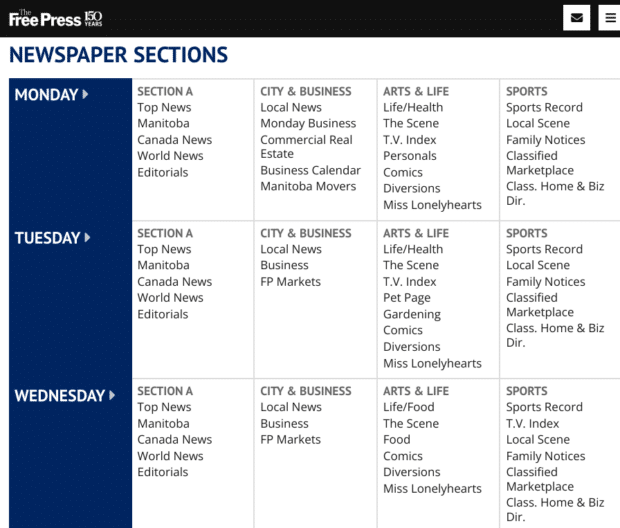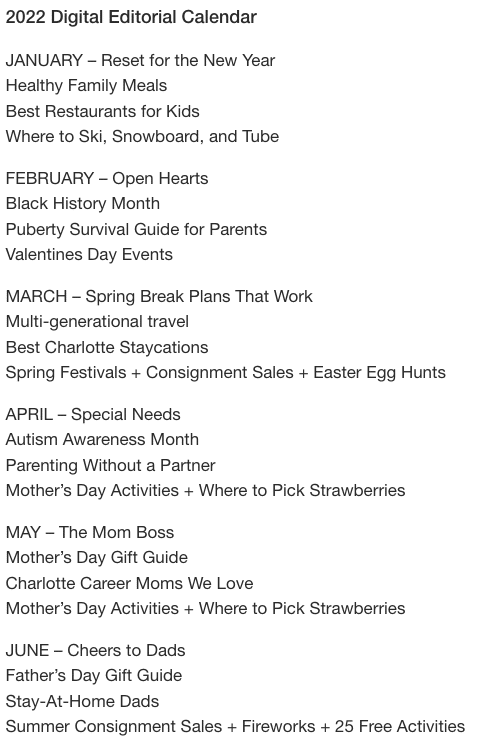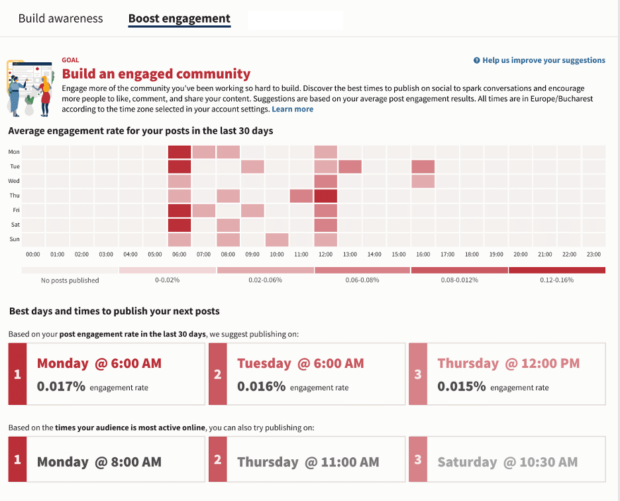A social media calendar is a lifesaver for busy social marketers.
When you create and post content on the fly, you’re prone to typos, tone problems, and other mistakes. It’s much safer—and more efficient—to dedicate a specific time in your workday to create, tweak, proofread, and schedule posts.
In addition to making your workday less stressful, a social media calendar can help you plan an effective content mix. You can look for opportunities to reinforce social messaging across platforms. And, you’ll be able to time your posts to reach the largest possible audience.
Read on and we’ll guide you through the steps necessary to make your own, functional social media content calendar. We’ve included some free social media calendar templates to get you started!
A social media calendar is an overview of your upcoming social media posts. It can be organized in the form of a spreadsheet, Google calendar or interactive dashboard (if you’re using a social media management tool).
A social media calendar usually includes some combination of these elements for each post:
- The date and time it will go live
- The social network and account where it will be published
- Copy and creative assets (i.e., photos or videos) required
- Links and tags to be included
1. Get organized and save time
Social media content creation and posting take time and attention every single day. A social media calendar lets you plan ahead, batch your work, avoid multitasking, and note down all your content ideas for later.
Social media planning calendar tools even allow you to schedule social media posts ahead of time to post automatically, so you can share content every day without logging into all your social platforms every hour on the hour.
The average internet user regularly uses 7.5 social media platforms. For social media managers, the number can be much higher. Getting organized with a social media calendar and pres-scheduled posting is a critical part of managing multiple accounts.
Putting a little work in upfront to plan your content frees up time to use the higher-value (and more fun) skills in your toolbox, like strategic planning and campaign brainstorming.
2. Make it easier to post consistently
There is no hard and fast rule about how often you should post on social media. That said, there are some generally accepted best practices to use as a baseline.
The most important rule, no matter how often you decide to post, is to post on a consistent schedule.
Sticking to a regular schedule is important so your followers and fans know what to expect. It’s also a good way to make clever (rather than cringey) use of weekly hashtags like #MondayMotivation. (Personally, I prefer #MonsteraMonday, but that might not be for everyone.)
For a real-world example, take a look at the weekly content calendar for The Winnipeg Free Press. True, this is not specifically a social media content calendar, but it’s a content calendar all the same. And it shows how a weekly plan can help anchor consistent content ideas.

Source: Winnipeg Free Press
A content framework like this gives you one less thing to think about as you create your posts each week. And scheduling your posts in advance allows you to stick to your posting schedule while also ensuring you have quality content queued up and ready to go.
Social media calendar tools ensure you post consistently at the optimal times for your audience, even if those times don’t line up with your core working hours, which leads us to…
3. Your time off is really time off
When your content is planned out in advance, and you’ve set up your content to post automatically at the right times, you can actually take time off. No logging into your work accounts on Thanksgiving, or late at night, or early in the morning.
It’s no exaggeration to say that for busy social media managers, creating a social media calendar is an act of self-care.
Reminder to our community, check in on your mental health. Take a break away from your screens when you can ❤️
— Hootsuite 🦉 (@hootsuite) March 4, 2022
4. Reduce typos and avoid big mistakes
Planning posts ahead of time allows you to check your work and build a safety net into your workflow. Copy-editing, fact-checking, and clearing content with organizational stakeholders are all much easier when you’re working in advance.
A social media calendar—especially one with team member approvals built in—is the best way to prevent everything from mildly embarrassing mistakes like minor typos all the way up to a high-key social media crisis.
5. Make higher-quality content and cohesive campaigns
Social media production values have skyrocketed since the early days. Today, it’s not unusual for a single social media post to have a whole team of creatives behind it: copywriters, designers, video editors, photographers, and maybe even makeup artists and stylists.
Asking your team to drop everything for an emergency Instagram Reel is not going to win hearts or minds. And it’s not going to result in your best possible content or a cohesive account. A social media calendar helps you allocate your assets—both human and digital—effectively, so that your team has the breathing room to do their best work.
A long-term plan allows you to craft a consistent brand voice and content that supports your social media marketing goals and beyond.
6. Time your content to important holidays and events
Planning your content in a calendar forces you to keep an eye on what’s happening in, well, the calendar. This means you’re prepared for everything from Daylight Savings Time to the Super Bowl. (And everything in between: We’re looking at you, National Pizza Day.)
we know pineapples on pizza is controversial, but how about on final score graphics since it’s #nationalpizzaday? 😅 pic.twitter.com/AQ2P2P1J2v
— Seattle Kraken (@SeattleKraken) February 10, 2022
We’ve created a Google Calendar of holidays you can use to frame social media posts, and you can easily import it into your own Google Calendar to give your content planning a little extra relevance.
Borrowing from the publishing world again, take a look at the editorial calendar for Charlotte Parent magazine. It clearly shows how the overall content themes and specific articles planned for the year align with relevant events, like Mother’s Day and Father’s Day.

Source: Charlotte Parent
7. Spot opportunities for partnerships or sponsored content
Aside from timing your in-house content to both mainstream and obscure holidays and events, planning your content in advance gives you the lead time to think about opportunities to partner with other brands. Or to approach influencers about working together on sponsored content.
It also makes it easier to coordinate your organic and paid content, so you can make the most of your social advertising dollars.
Influencers and bloggers likely have their own editorial content calendars, which you could access through their media kits. This is another opportunity to look for partnership opportunities through content planning.
8. Track what works, and improve it
What gets scheduled gets done, and what gets measured gets improved.
Your social media analytics have a lot of insights for you. A social media content calendar provides the opportunity to study and absorb that information and tie what you learn back to the content you planned. Then, you can work on improving lackluster results and producing more of your best content.
Use your calendar to plan out an A/B testing strategy to guide you towards the right type of content, format, post frequency, and time of day to post for each social platform.
For example, Hootsuite makes room in its posting calendar for social media experiments to make sure the team is working from real-world results, not just theories.
Before you can start building your social media posting calendar, you need to have a clear picture of your existing social media accounts.
Use our social media audit template to create a precise, up-to-date record of:
- Impostor accounts and outdated profiles
- Account security and passwords
- Goals and KPIs for each branded account, by platform
- Your audience, their demographics and personas
- Who’s accountable for what work on your team
- Your most successful posts, campaigns and tactics
- Gaps, underwhelming results, and opportunities for improvement
- Key metrics for measuring future success on each platform
As part of your audit, make a note of how often you’re currently posting on each social network. Also look at your analytics for any clues about how your posting frequency or time of posting impacts engagement and conversions.
Deciding what kinds of content to post is a key part of your social media strategy — and an important step to building a social media calendar. There are a couple of standard content mix formulas you can use to get started:
The social media rule of thirds
- One-third of your posts promote your business or drive conversions.
- One-third of your posts share curated content from industry thought leaders.
- One-third of your social posts involve personal interaction with your followers.
The 80-20 rule
- 80 percent of your posts are designed to inform, educate, or entertain
- 20 percent of your posts directly promote your business or drive conversions
You’ll also need to determine which social channels to use for which types of content, and which ones may not be necessary for you at all.
Don’t forget to schedule in user-generated content and curated content so you don’t get overwhelmed creating everything yourself.
Your social media calendar won’t look exactly like anyone else’s. For example, a small business owner doing their own social posting will likely have a much simpler calendar than a large brand with a full social team.
To get the most out of your social calendar, map out the information and functionality that’s most important to you.
It’s generally a good idea to start with basic details, like:
- Platform
- Date
- Time (and time zone)
- Copy
- Visuals (e.g., photo, video, illustration, infographic, gif, etc.)
- Link to assets
- Link to published post, including any tracking info (like UTM parameters)
You may also want to add more advanced details, like:
- Platform-specific format (feed post, Story, Reel, poll, live stream, ad, shoppable post, etc.)
- The associated vertical or campaign (product launch, contest, etc.)
- Geo-targeting (global, North America, Europe, etc.)
- Paid or organic? (If paid, then additional budget details might be helpful)
- Has it been approved?
You can get started with a simple spreadsheet. But sometimes a spreadsheet is not enough, which is why we include our favorite calendar tools at the end of this post.
4. Invite your team to review, and use their feedback to improve
Your calendar is most effective when it makes sense to everyone who has to use it in their work. Ask for feedback and ideas from stakeholders and your team to make sure it serves everyone’s needs.
As you start to work with your calendar, evaluate how it feels to you, and ask the team to provide ongoing feedback. If it feels onerous and finicky, maybe you want to dial back some of the detail. Or maybe it’s not detailed enough and you need to add a few columns.
At the end of this step, you should have an airtight document that even the newest team member can understand.
We’ve created two Google Sheets templates for you to use as a basis for your own social media calendar. Just open the link, make a copy, and plan away.
Social media calendar template
This social media content calendar template makes space for the big five major platforms (Facebook, Instagram, Twitter, LinkedIn and TikTok). But it’s highly customizable, and you’re free to make it your own with the channels that make sense for you.
Make sure to create a new tab for each month, and plan out your editorial content week by week.
Among the many helpful items in this calendar, don’t miss the tab for evergreen content. This is a content repository for blog posts that always perform well on social, despite seasonality.
This template includes columns for you to track and schedule:
- Type of content
- Original publication date (keep track of this so you know when it’s time for an update)
- Title
- Topic
- URL
- Top-performing social copy
- Top-performing image
Social media editorial calendar template
This template is intended for planning individual content assets. Think blog posts, videos, new research, and so on. In other words, this is where you plan out the content that your social media efforts will be promoting.
Create a new tab for each month, and plan your editorial content out week by week.
Social media content calendar apps and tools
Honestly, there are probably as many different social media content calendar tools as there are social media managers. These are our favorites.
Google Sheets
Sure, Google Sheets is not fancy. But this free, cloud-based spreadsheet tool certainly makes life easier. A simple Google Sheet is a good home for your social media calendar, especially if you use one (or both) of our templates as your starting point.
It’s free, it’s easy to share with team members and stakeholders, and it works.
Hootsuite Planner
Hootsuite Planner takes things to the next level by allowing you to draft, preview, schedule and publish all of your social media posts directly from its interactive calendar. It works with Facebook, Instagram, Twitter, LinkedIn, YouTube and Pinterest.
The social media calendar you can build with Hootsuite’s planner is interactive. You get your visual overview, all your assets (copy, visuals, links) in one place. From there, you can easily publish, schedule or edit your posts.
If you’re part of a bigger social media team, you can easily share the calendar with your coworkers and managers, and even create custom approval workflows that will help you keep always keep your busy content calendar in check.
Hootsuite will even suggest the best time to post for each of your social media accounts, directly within the publishing interface.

To learn more about scheduling and publishing content with Hootsuite, watch this video:
Once you’ve planned your social media content calendar, use Hootsuite Planner to schedule all of your social media posts, engage with your followers, and track the success of your efforts. Sign up for a free trial today.
Do it better with Hootsuite, the all-in-one social media toolkit. Stay on top of things, grow, and beat the competition.